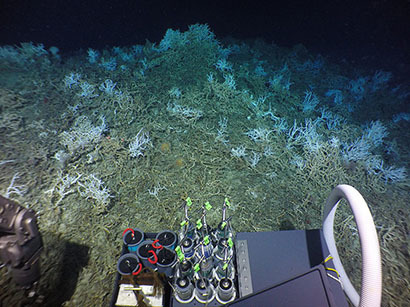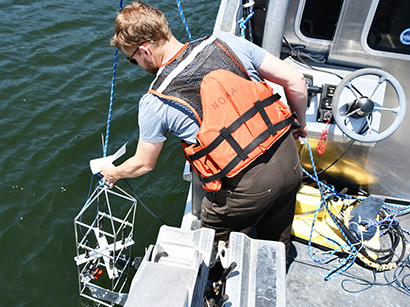Bloede Dam, Complicated Dam Removal Effort Underway
The removal of Bloede Dam, the lowermost dam on the Patapsco River in Maryland, will revitalize fish and wildlife vital to the Chesapeake Bay and benefit public safety and recreational use. NOAA, American Rivers, the Maryland Department of Natural Resources, and others recently celebrated the beginning of the Bloede dam removal, which will open the river and restore more than 65 miles of spawning habitat for blueback herring, alewife, American shad, and hickory shad in the watershed, and more than 183 miles for American eel. This effort is one of the largest and most complicated dam removals in NOAA’s history. Learn More >
 |
Amazing deep-sea coral habitat was recently discovered during a NOAA Deep Sea Coral Research and Technology Program co-sponsored research expedition with partners including from the Bureau of Ocean Energy Management, the U.S. Geological Survey, and academia on the Woods Hole Oceanographic Institution-operated R/V Atlantis. Researchers uncovered previously unknown dense forests of cold water corals and a reef estimated to run for at least 85 linear miles (almost as long as Delaware). This was a two week expedition between Virginia and Georgia to collect critical baseline information on deepwater habitats and high-resolution mapping with daily dives using human occupied vehicle, Alvin. Learn More >
 |
NOAA and Ducks Unlimited are teaming up to restore habitat damaged from oil spills and hazardous waste releases. An initial cooperative agreement between the two organizations includes $1.8 million for restoration activities in the Gulf of Mexico, in coordination with the State of Texas. This new chapter in our partnership with Ducks Unlimited has potential for additional funding to support similar projects in other regions over a five-year time period. This funding will support work on marine and coastal habitat conservation and restoration goals related to the Deepwater Horizon oil spill. Learn More >
 |
In the Chesapeake Bay, the oyster population is only 1-2% of what it historically was due to disease, poor water quality, and overharvesting. Realizing the many benefits oysters bring, NOAA and other agencies are partnering to restore oyster reefs in selected tributaries of the Chesapeake. The NOAA Chesapeake Bay Office provides critical science through sonar surveys of potential restoration sites, habitat mapping and analysis, and monitoring for success. Learn More >
 |
By bringing together the diverse expertise of NOAA and our partners, Habitat Focus Areas (HFAs) are conducting new research, developing tools to inform management decisions, and working with local communities. Sea Grant—a Federal-University partnership between NOAA and 33 programs based at universities across the country—is a natural partner for many of the HFAs. With their focus on research, on-the-ground extension services, and education for coastal and Great Lakes communities, the network of Sea Grant professionals are collaborating with HFAs in diverse ways around the country. Here is a look at some of those collaborations. Learn More >
 |
NOAA and partners have been studying the physical and biological effects of dam removal projects to understand and predict what will happen to the area when a dam is removed. Aging dams are being removed around the Northeast and throughout the country to improve public safety and restore river ecosystems. Dam removals present challenges for project planners and local community members who are concerned about potential impacts from trapped sediment. Learn More >
Deep Water Horizon Trustee staff and partners working to restore bird habitat on North Breton Island, Louisiana recently began scientific testing of the sand and invertebrates that live there, to prepare for the upcoming construction phase. The island’s restoration is one part of our ambitious, $318 million Louisiana Outer Coast Restoration Project. Learn More >
In the Great Lakes, NOAA’s is partnering with the Friends of the Detroit River. This dedicated group of local citizens is charged by the U.S. Environmental Protection Agency to work in support of the Detroit River Public Advisory Council. Together, we’re cleaning up and restoring the Detroit River, which is listed as a Great Lakes Area of Concern due to high levels of pollution from decades of industry and development. Learn More >
National Estuaries Week is a nationwide celebration of our bays and estuaries and the many benefits they provide to communities. This year, the 30th anniversary, National Estuaries Week will be held September 15-22. We encourage everyone to participate – share your projects on social media, organize a community event, and talk with your local representatives about the importance of healthy, vibrant estuaries. Learn More >
It’s almost that time of year—time for the International Coastal Cleanup (ICC)! This annual event, put on by the Ocean Conservancy and supported by the NOAA, works to bring people together from across the globe to clean up marine debris in their local communities. Last year’s cleanup resulted in more than 10,000 tons of trash collected by over 789,000 volunteers covering almost 18,000 miles! That helps a lot of coastal habitats. With so many miles covered, you can bet there will be a cleanup near you. Learn More >
|